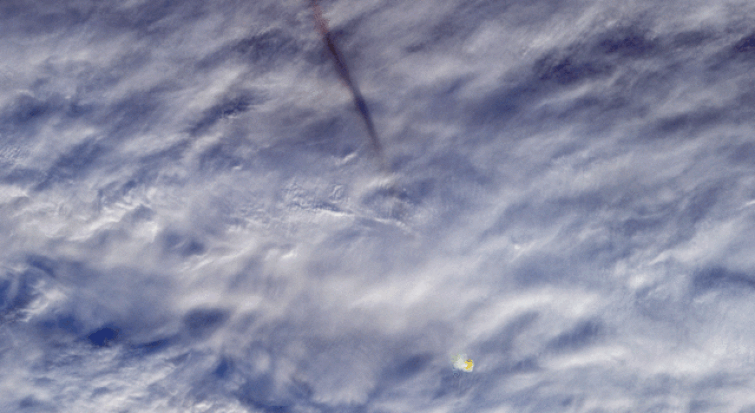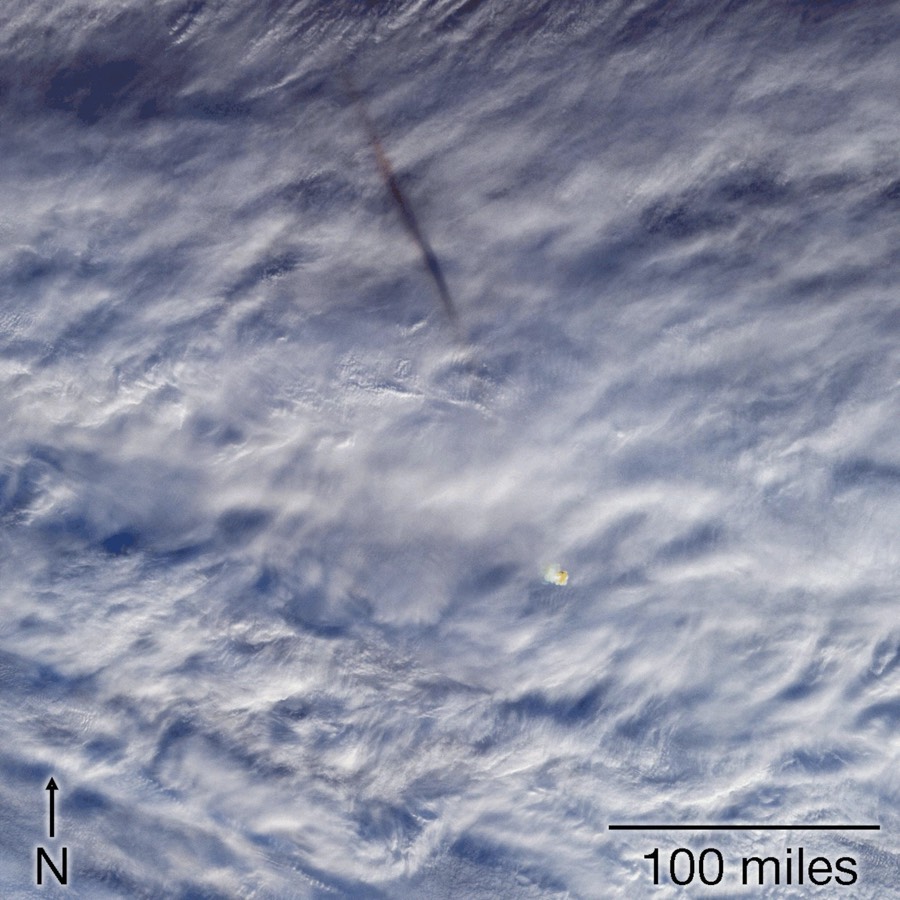'Unseen' Meteor That Exploded Over Bering Sea Caught on Camera After All

A meteor that snuck by the world's telescopes and exploded over the Bering Sea was caught on camera after all.
Two instruments on NASA's Terra satellite caught images of the fireball explosion on Dec. 18, 2018. The meteor's trail is visible in the top portion of the photo as a dark, streak-like shadow on the cloud tops. Toward the lower right of the image is an orange cloud of superheated air created by the explosion.
NASA scientists estimate that the meteor was 32 feet (10 meters) in diameter and weighed 1,500 tons (1,360 metric tons). It blasted through the atmosphere at 71,582 mph (115,200 km/h) and exploded 15.5 miles (25 kilometers) above the surface of the ocean. It exploded with the power of 173 kilotons of TNT, 10 times the energy of the atomic bomb dropped by the United States over Hiroshima in 1945. [Top 10 Greatest Explosions Ever]
Small but mighty
Despite this power, the meteor was smaller than the space rocks on which NASA focuses its sky-scanning resources. The space agency watches for near-Earth objects in the range of 460 feet (140 m) across and larger, which would wipe out an entire U.S. state.
That small size and the remoteness of the Bering Sea explains why this image of the asteroid comes only after the fact. It was captured by Terra's Moderate Resolution Imaging SpectroRadiometer (MODIS) and its Multi-angle Imaging SpectroRadiometer (MISR).

According to NASA, the fireball was the largest observed since 2013, but posed no threat given how high it was when it exploded and the fact that the explosion occurred over an unpopulated region. A scientist with NASA, near-Earth object observation program manager Kelly Fast, publicized the explosion last week in a presentation at the Lunar and Planetary Science Conference in Texas.
Historical fireballs
Space rocks are a rare danger on Earth, but meteors do occasionally cause problems. The most dramatic fireball in recent memory was the 2013 Chelyabinsk meteor, which streaked over Russia and exploded about 18.5 miles (29.7 km) above the ground. [See Images of the Russian Meteor Explosion]
Sign up for the Live Science daily newsletter now
Get the world’s most fascinating discoveries delivered straight to your inbox.
That meteor was approximately 66 feet (20 m) in diameter, twice the size of the Bering Sea fireball. It exploded with a blast equivalent to 400 to 500 kilotons of TNT, and the shock wave injured more than 1,000 people, 112 seriously enough to be admitted to the hospital. Most were hurt by glass shattered by the explosion, though some experienced eye pain and ultraviolet burns from the intense light and heat of the blast.
The Chelyabinsk meteor was the biggest to enter the atmosphere since the meteor that caused the Tunguska event in 1908. On June 30 of that year, a meteor exploded 6 miles (10 km) or so above Eastern Siberia, flattening hundreds of square miles of forests. It's unclear how large the Tunguska meteor was, but the lowest estimates put it at three times the size of the Chelyabinsk meteor.
- Crash! 10 Biggest Impact Craters on Earth
- In Photos: The Impact Craters of North America
- Fallen Stars: A Gallery of Famous Meteorites
Originally published on Live Science.

Stephanie Pappas is a contributing writer for Live Science, covering topics ranging from geoscience to archaeology to the human brain and behavior. She was previously a senior writer for Live Science but is now a freelancer based in Denver, Colorado, and regularly contributes to Scientific American and The Monitor, the monthly magazine of the American Psychological Association. Stephanie received a bachelor's degree in psychology from the University of South Carolina and a graduate certificate in science communication from the University of California, Santa Cruz.










